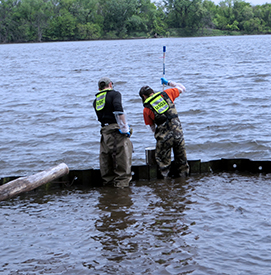Delaware • New Jersey • Pennsylvania
New York • United States of America
 |
| L to R: USGS Hydrographers Daniel Skulski, Lucas Sirotniak, Jacob Gray & Kathryn Cahalane prep the Fluidion Alert System for re-installation. Photo by the DRBC. |
In May 2022, USGS scientists re-deployed a Fluidion Alert System - one of the first in the nation - to monitor near real-time Delaware River bacteria concentrations in Camden's Pyne Poynt Park.
The DRBC is collaborating with the USGS on this effort.
The system was first deployed in 2021 and was removed for the winter season.
• News Release announcing initial deployment: New Technology Allows Bacteria to be Monitored in Near Real-Time in the Urban Corridor of the Delaware River (Oct. 2021)
Since the mid-1960s, the DRBC has been monitoring bacteria concentrations in the Delaware Estuary (the tidal portion of the river and bay) through its Delaware Estuary Water Quality Monitoring Program. These data are collected from the center channel of the river.
• Learn more: Delaware Estuary Water Quality Monitoring Program
Since 2019, the DRBC has been monitoring near-shore bacteria levels at nine locations in the estuary around Philadelphia and Camden. Five locations are monitored in New Jersey and four in Pennsylvania. The purpose of this monitoring program is to see if bacteria levels in this section of the river are conducive for close contact recreational activities.
• Learn more: Bacteria Monitoring Program
Bacteria levels are affected by wastewater discharges, animal waste and stormwater runoff, and concentrations can change rapidly in this stretch of river. Bacteria data are important to water resource managers and local officials as they affect public health and recreation.
The Fluidion Alert System can remotely sample on demand and provide results the same day, rather than the typical three days traditional sampling methods take. Accuracy will be checked by comparing results produced by the system with results from discrete samples collected and analyzed by a lab. This will test functionality as well as feasibility for use as an early detection system. It will be deployed until October 2022.
The DRBC thanks USGS N.J. Water Science Center Hydrographers Daniel Skulski, Jacob Gray, Lucas Sirotniak and Kathryn Cahalane for their efforts and looks forward to working with them on this project.
- USGS New Jersey Water Science Center
- USGS Next Generation Water Observing System: Delaware River Basin
- USGS Delaware River Dashboard
Funding for the Fluidion Alert System was generously provided by the U.S. EPA Urban Waters Federal Partnership and the William Penn Foundation.
Editor’s Note: Fluidion is a registered trademark of Fluidion SAS of Creteil, France.
 |
 |
 |
| The site location for the Fluidion Alert System. Photo by the DRBC. |
The Fluidion Alert System. Photo by the DRBC. |
USGS Hydrographers Lucas Sirotniak and Jacob Gray prep for re-deployment. Photo by the DRBC. |
 |
 |
 |
| USGS hydrographers Daniel Skulski, Lucas Sirotniak and Kathyrn Cahalane prep the Fluidion Alert System for re-deployment. Photo by the DRBC. | USGS Hydrographers Kathryn Cahalane, Jacob Gray and Daniel Skulski record data at the site location. Photo by the DRBC. | Water quality readings were taken at the site location. Photo by the DRBC. |
Copyright © Delaware River Basin Commission,
P.O. Box 7360, West Trenton, NJ 08628-0360
Phone (609)883-9500; Fax (609)883-9522
Thanks to NJ for hosting the DRBC website